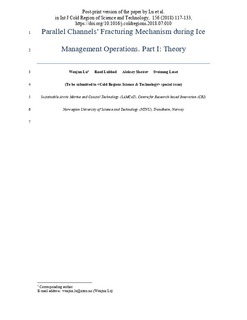| dc.contributor.author | Lu, Wenjun | |
| dc.contributor.author | Lubbad, Raed | |
| dc.contributor.author | Shestov, Aleksey | |
| dc.contributor.author | Løset, Sveinung | |
| dc.date.accessioned | 2019-04-02T07:06:24Z | |
| dc.date.available | 2019-04-02T07:06:24Z | |
| dc.date.created | 2018-12-06T14:34:21Z | |
| dc.date.issued | 2018 | |
| dc.identifier.citation | Cold Regions Science and Technology. 2018, 156 102-116. | nb_NO |
| dc.identifier.issn | 0165-232X | |
| dc.identifier.uri | http://hdl.handle.net/11250/2592809 | |
| dc.description.abstract | It is frequently observed that long cracks in sea-ice tend to form between parallel channels during ice management operations. The long cracks that develop play an important role in reducing the size of the managed ice floes, which is one of the main goals in an ice management operation. However, the fracture mechanism behind these long cracks remains unclear. To address this issue, a comprehensive study is reported here in two associated papers. In the current paper (i.e., Paper I), an edge-crack theoretical model is proposed to elucidate the parallel channels' fracture mechanism. The proposed theoretical model is partially based on theories regarding ship – level ice interactions and partially based on previous studies on the general ice fracturing mechanism. The edge-crack theoretical model is extensively examined using a separately developed numerical scheme based on the eXtended Finite Element Method (XFEM), which allows for the existence of a singularity field and displacement jump within conventional Finite Elements (i.e., FEM). The numerical scheme is benchmarked against known asymptotic analytical solutions and field experiments. Afterwards, with the developed numerical scheme, through fitting numerical simulation results in terms of the edge crack's Stress Intensity Factors (SIFs) and a relevant asymptotical analysis, we managed to derive a group of closed-form formulae with wide application ranges. For the current engineering problem, this set of formulae quantifies the maximum parallel channel spacing hmax, beyond which the observed parallel channels' fracturing events cease to occur. Moreover, the same numerical scheme is utilised to study parallel channels' fracturing paths. Based on the XFEM-based crack path simulations, a second group of formulae and a numerical recipe were obtained to characterise a simplified crack path. This set of equations enables us to quantify the maximum floe size LMCD that can be generated between two parallel channels and its corresponding floe size ratio. In the sequel paper (i.e., Paper II), these equations are validated by a series of well-controlled field experiments undertaken during the Oden Arctic Technology Research Cruise of 2015 (OATRC2015). | nb_NO |
| dc.language.iso | eng | nb_NO |
| dc.publisher | Elsevier | nb_NO |
| dc.rights | Attribution-NonCommercial-NoDerivatives 4.0 Internasjonal | * |
| dc.rights.uri | http://creativecommons.org/licenses/by-nc-nd/4.0/deed.no | * |
| dc.title | Parallel channels' fracturing mechanism during ice management operations. Part I: Theory | nb_NO |
| dc.type | Journal article | nb_NO |
| dc.type | Peer reviewed | nb_NO |
| dc.description.version | acceptedVersion | nb_NO |
| dc.source.pagenumber | 102-116 | nb_NO |
| dc.source.volume | 156 | nb_NO |
| dc.source.journal | Cold Regions Science and Technology | nb_NO |
| dc.identifier.doi | 10.1016/j.coldregions.2018.07.010 | |
| dc.identifier.cristin | 1639937 | |
| dc.relation.project | Norges forskningsråd: 203471 | nb_NO |
| dc.description.localcode | © 2018. This is the authors’ accepted and refereed manuscript to the article. Locked until 20 July 2020 due to copyright restrictions. This manuscript version is made available under the CC-BY-NC-ND 4.0 license http://creativecommons.org/licenses/by-nc-nd/4.0/ | nb_NO |
| cristin.unitcode | 194,64,91,0 | |
| cristin.unitname | Institutt for bygg- og miljøteknikk | |
| cristin.ispublished | true | |
| cristin.fulltext | original | |
| cristin.qualitycode | 2 | |

